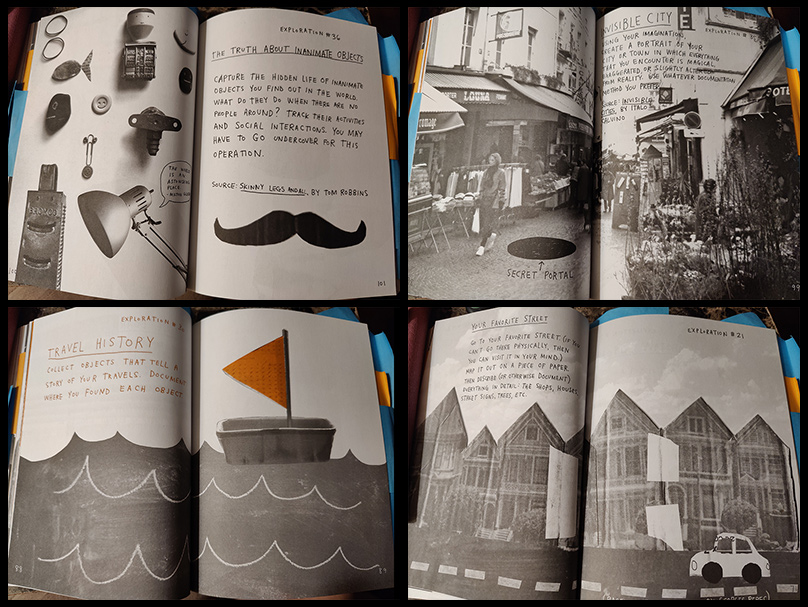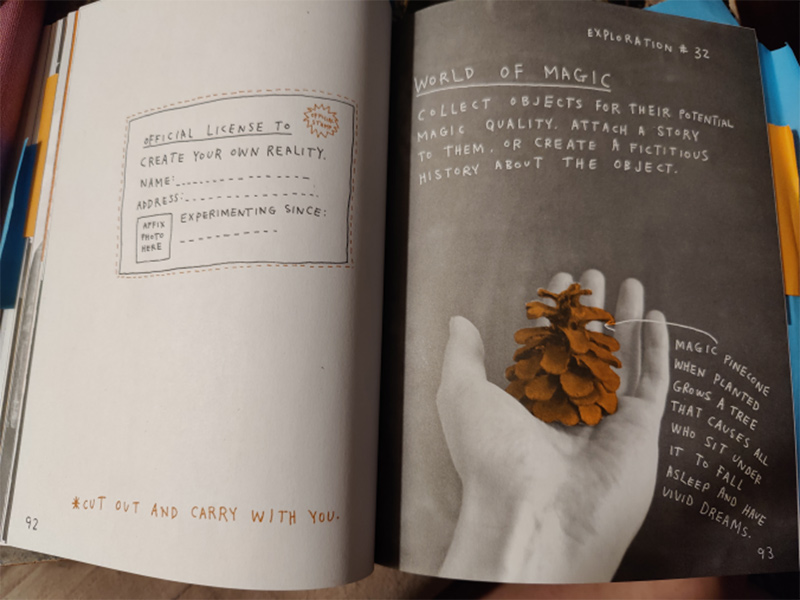For several of the explorations I’ve done on this journey, I’ve tried to purposefully push myself outside of my comfort zone by exploring areas that I don’t know very well. This final week, I want to push myself outside of my comfort zone by doing something that is actually well within my comfort zone but that I don’t frequently share publicly: creative writing.
Lesson #1: Even that which is comfortable can help break your own barriers.
As I’ve flipped through the pages of How to Be an Explorer of the World by Keri Smith, I’ve noticed several explorations that sound like great writing prompts. Exploration #21 that asks for a detailed description of your favorite street could be a good exercise in describing setting. Collecting artifacts of previous travels and writing about each one in Exploration #30 is a great way to start writing a memoir. A couple of them get even more creative with Exploration #32: World of Magic, Exploration #35: Invisible City, and Exploration #36: The Truth About Inanimate Objects, all of which ask the explorer to use the imagination to give regular, inanimate objects magical or humanlike qualities.

I mentioned in an earlier post when I was counting words that I’m working on writing a novel. For a long time the only people who even knew I was writing a novel were my husband, my mother, and a friend or two. I’ve only recently gotten comfortable with talking about my writing to anyone else. In fact, even as I write this, I’m not entirely sure I won’t cut it out before I’m done.
I’m actually about halfway through writing the third book of the series, and I recently got my draft of the first book back from a professional editor. I’ve been working on this project as a hobby for years, always waffling about whether it’s just a hobby for myself or if I want to eventually seek publication. Recently, I made the decision to try to publish, leaving me with two new choices to waffle between: traditional publishing or self publishing. Of course, neither will ever happen if I can’t find the time to keep writing.
Exploration #32: World of Magic
Partially as an exercise in getting more comfortable with sharing my creative writing side with the world and partially as a desperate attempt by that creative side to see a bit more use, I’ve decided to undertake Exploration #32: World of Magic. I chose this from the selection of creative writing prompts because it most closely aligns with the type of stories that I like to write, which are mainly supernatural with a heavy focus on magic.

This exploration asks the reader to “Collect objects for their potential magic quality. Attach a story to them, or create a fictitious history about the object.” I’ve chosen to interpret this exploration as a short story writing prompt inspired by a single object. The challenge for me with this particular prompt is in the style of writing. My stories tend to be heavily character-driven, and while I think I do build interesting and nuanced magical worlds, I usually describe these worlds through the eyes of a first-person main character. That leaves me to decide if I want to describe the magical history of this object alone or create a character to interact with it. I also need to decide if I should start from scratch or build on something I’ve already started or brainstormed.
Lesson #2: There are always a million things to decide before getting started on a new project.
Before I begin this short story, I ask that you remember when reading this that it is essentially a quickwrite, an unedited first draft, an exercise in creative writing, not a polished or publishable finished product. Judge accordingly.
The Photo Album
The first rays of the morning sun shone through the pane of glass that made up the floor-to-ceiling display window at the front of the shop, illuminating tiny specks of dust floating in the air. If someone were to walk into the store at just that moment, they would find themselves in a typical bookshop. If they’d never been to this typical book shop, they might be surprised to find that the shop, much like the TARDIS on Doctor Who, seemed to be bigger on the inside, with rows of bookshelves extending much farther than the eye can see. The first rows were shiny and new, the shelves a crisp, bright white, and the books mostly hardcovers with pristine dust jackets. As the shop made a turn to the right, the shelves turned to dark woods and the books became older, showing signs of age and use.
In the farthest dark corner of the shop, on a wooden bookshelf that looked so precarious that it may have been the books themselves holding it together, sat a photo album. It appeared used, like many of the other books on this particular shelf, but no photos had ever been placed in this particular photo album. A bright orange sticker proclaimed a price of only five dollars, but no one has found it worthy of the cost. Until today.
At precisely 8 am, the shop owner arrived, unlocked the door, and took her morning post behind the counter to review the paperwork associated with operating a bookshop. The photo album remained in its place beside a used copy of A Tale of Two Cities.
Exactly two hours later, the first customers arrived, two young women, newly married. The shop owner, having completed her morning paperwork, emerged from between two bookshelves where she had been rearranging books that had been shuffled around by a group of teenagers the day before.
While the shop owner helped one locate the books of a series she’d recently begun reading, the other wandered off to explore, choosing to let a book find her rather than her finding a book.
And so she found herself in the farthest dark corner of the shop, flipping through the words of Charles Dickens, remembering being a high school senior and reading A Tale of Two Cities in her AP English class. As she set the book gently back in its place, the plain black leather cover of the old photo album caught her eye.
She picked up the album wondering if it would be a good choice for the wedding photos that would be ready soon, but when she flipped it open to the middle, she found it was already filled with pictures.
When I told you earlier that no photos had ever been placed in this particular photo album, I did not lie. The album is a truly special object, worthy of far more than its five dollar sticker.
Just as she was going to put the album back on the shelf with a thought that it would be too much work to remove the photos to be worth it, she noticed a familiar face in one of the photos. Her own.
The photo appeared to have been taken in a bar she used to frequent, which also happened to be where she met her wife. In fact, she realized this photo seemed to show the exact moment they met. She examined it more closely, wondering who had taken the photo and if it would technically be stealing if she removed this single priceless memory from the album and put it in her pocket.
She turned to the next page and found a series of photos that again showed her face. These photos seemed to be taken the following week when they’d gone on their first date. Filled with confusion, she turned to the next page and found photos of later dates. She flipped back to the beginning of the album and found a Polaroid of an infant wrapped in a pink blanket, her own name written in a loose cursive scrawl across the bottom. Flipping forward, she found photos of herself as a toddler, in school, packing for college, and so on through her life up to the final photo in the album. Some photos showed significant events in her life, while others appeared to be simple everyday activities, but none were photos she had ever seen before or remembered anyone taking. The final photo was definitely not one she had ever seen, as their wedding photographer had yet to send them even a preview of the photos from the most special day of her life.
Following the single wedding photo, the album contained several empty pages, the feeling of anticipation in those empty pages nearly palpable in her throat.
With a sudden certainty, she recognized the magic of this photo album as the priceless gift that it is. With a feeling of reverence, she gently closed the album and carried it to the front, where she paid the five dollars, and placing her hand in her wife’s, took it to its new home on a similar wooden bookshelf between a cute succulent planter and an old marked-up copy of A Tale of Two Cities.
Reflection
I have to say that I’m quite pleased with how this little story turned out. I humbly believe it’s pretty good, and I may someday explore this story a bit further to answer some questions left by this short story, in particular the question of whether the photos will stay in the album the next time she opens it and what her wife will see when she looks in the album. However, I always enjoy when a story leaves the reader with a few unanswered questions, just to keep them thinking.
Lesson #3: Some of the best questions are those that remain unanswered.
To go back to the original exploration, I don’t have a picture of the photo album that inspired this story because it is back home (filled with my own childhood photos), and I’m currently in San Diego for an educational research conference, but I assure you that it was based on a real object found in the world. However, the bookshop described here is an amalgamation of every bookshop I’ve ever visited, and the three characters are completely fictional. The whole story stemmed from that one single object.
Lesson #4: A single object can be an excellent source of data.
I’ll wrap this post up with one final overarching lesson from my 14-week journey to becoming an explorer of the world.
Lesson #5: Never stop exploring.

Tools like Credo Reference are great for more than simply researching topics. As a repository of information, it’s up to the user what to do with that information. It can be used to build lessons for a history class just as easily as it can be used for a student in that same class to write a research paper. A potentially unexplored use is to improve your skills. As a hobbyist writer, I know that there will always be much about writing that I can learn. I could read about other writers and take solace in the number of rejections that famous authors suffered through before catching their big break or I could also read about the writing process itself and pick up new tricks.
However you use Credo Reference, keep just one thing in mind. Learning, in any form, is always its own form of magic.
Learn more about Credo Reference for colleges and universities and public libraries, and take a FREE TRIAL today!
Originally published on Mrs. Hebert’s Classroom on April 24, 2022. You can also listen to the podcast here:
Like this article? Check out the previous blog articles in this series:
- Learning to Be an Explorer of the World
- Exploring the World in Words
- Exploring Pointillism in My Backyard
- Exploring the Farmers Market
- Exploring Beyond My Comfort Zone
- The Sounds of Exploration
- Exploring the Past (Without Time Travel)
See also:



